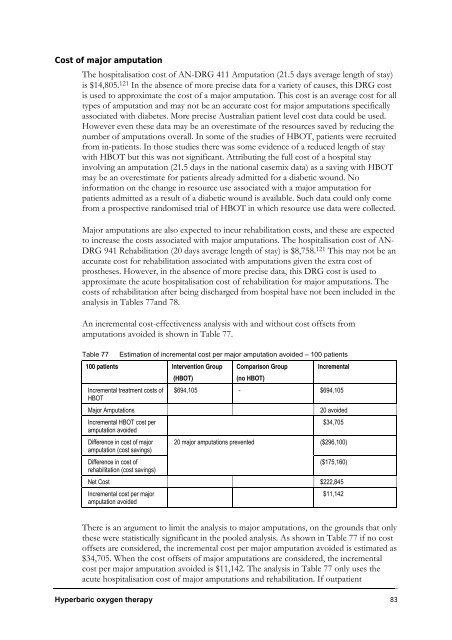Hyperbaric Oxygen Therapy - Hyperbaric Chamber Information ...
Hyperbaric Oxygen Therapy - Hyperbaric Chamber Information ...
Hyperbaric Oxygen Therapy - Hyperbaric Chamber Information ...
You also want an ePaper? Increase the reach of your titles
YUMPU automatically turns print PDFs into web optimized ePapers that Google loves.
Cost of major amputation<br />
The hospitalisation cost of AN-DRG 411 Amputation (21.5 days average length of stay)<br />
is $14,805. 121 In the absence of more precise data for a variety of causes, this DRG cost<br />
is used to approximate the cost of a major amputation. This cost is an average cost for all<br />
types of amputation and may not be an accurate cost for major amputations specifically<br />
associated with diabetes. More precise Australian patient level cost data could be used.<br />
However even these data may be an overestimate of the resources saved by reducing the<br />
number of amputations overall. In some of the studies of HBOT, patients were recruited<br />
from in-patients. In those studies there was some evidence of a reduced length of stay<br />
with HBOT but this was not significant. Attributing the full cost of a hospital stay<br />
involving an amputation (21.5 days in the national casemix data) as a saving with HBOT<br />
may be an overestimate for patients already admitted for a diabetic wound. No<br />
information on the change in resource use associated with a major amputation for<br />
patients admitted as a result of a diabetic wound is available. Such data could only come<br />
from a prospective randomised trial of HBOT in which resource use data were collected.<br />
Major amputations are also expected to incur rehabilitation costs, and these are expected<br />
to increase the costs associated with major amputations. The hospitalisation cost of AN-<br />
DRG 941 Rehabilitation (20 days average length of stay) is $8,758. 121 This may not be an<br />
accurate cost for rehabilitation associated with amputations given the extra cost of<br />
prostheses. However, in the absence of more precise data, this DRG cost is used to<br />
approximate the acute hospitalisation cost of rehabilitation for major amputations. The<br />
costs of rehabilitation after being discharged from hospital have not been included in the<br />
analysis in Tables 77and 78.<br />
An incremental cost-effectiveness analysis with and without cost offsets from<br />
amputations avoided is shown in Table 77.<br />
Table 77 Estimation of incremental cost per major amputation avoided – 100 patients<br />
100 patients Intervention Group Comparison Group Incremental<br />
(HBOT)<br />
(no HBOT)<br />
Incremental treatment costs of<br />
HBOT<br />
$694,105 - $694,105<br />
Major Amputations 20 avoided<br />
Incremental HBOT cost per<br />
amputation avoided<br />
Difference in cost of major<br />
amputation (cost savings)<br />
20 major amputations prevented<br />
$34,705<br />
($296,100)<br />
Difference in cost of<br />
($175,160)<br />
rehabilitation (cost savings)<br />
Net Cost $222,845<br />
Incremental cost per major<br />
$11,142<br />
amputation avoided<br />
There is an argument to limit the analysis to major amputations, on the grounds that only<br />
these were statistically significant in the pooled analysis. As shown in Table 77 if no cost<br />
offsets are considered, the incremental cost per major amputation avoided is estimated as<br />
$34,705. When the cost offsets of major amputations are considered, the incremental<br />
cost per major amputation avoided is $11,142. The analysis in Table 77 only uses the<br />
acute hospitalisation cost of major amputations and rehabilitation. If outpatient<br />
<strong>Hyperbaric</strong> oxygen therapy 83



